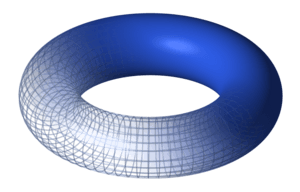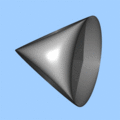Orientability facts for kids
In our normal 3D space, a surface is called orientable if you can't move a small flat shape (like a ![]() ) around on it and bring it back to where it started looking like its own mirror image (
) around on it and bring it back to where it started looking like its own mirror image (![]() ). Think of your right hand: no matter how you twist or turn it, it can never become a left hand. This means your hand is orientable.
). Think of your right hand: no matter how you twist or turn it, it can never become a left hand. This means your hand is orientable.
If a surface is non-orientable, it means you can move that small shape around and have it come back flipped, like a mirror image. A famous example of a non-orientable surface is the Möbius strip.

Contents
What is an Orientable Surface?
Imagine you are an ant walking on a surface. If you can always tell your "left" from your "right" as you walk, no matter where you go on the surface, then the surface is orientable.
A good way to think about it is with a small arrow pointing "up" from the surface. If you can move this arrow anywhere on the surface without it ever flipping upside down, then the surface is orientable.
Examples of Orientable Surfaces
Most surfaces we see every day are orientable.
- A sphere (like a ball) is orientable.
- A cylinder (like a can) is orientable.
- A torus (like a donut or an inner tube) is also orientable. On a torus, you can always keep track of which way is "up" or "down" from the surface.
Non-Orientable Surfaces
On a non-orientable surface, if you try to move that "up" arrow around, it will eventually flip over. This means that if you were an ant on such a surface, your "left" and "right" would switch without you crossing an edge.
The Möbius Strip
The most famous non-orientable surface is the Möbius strip. You can make one by taking a strip of paper, giving one end a half-twist, and then taping the ends together.
- If you draw a line down the middle of a Möbius strip, you will find that it only has one side!
- If you try to paint one side, you will end up painting the entire strip.
- An ant walking on a Möbius strip would eventually find itself on what it thought was the "other" side, but without ever crossing an edge.
Other Non-Orientable Surfaces
Another example of a non-orientable surface is the Roman surface, which is a more complex shape. These surfaces are fascinating because they challenge our everyday understanding of space and direction.
Images for kids
-
The Möbius strip is a non-orientable surface. Notice how the fiddler crab moving around it has its left and right sides flipped after a full trip. This would not happen if the crab were on a torus.
See also
 In Spanish: Orientabilidad para niños
In Spanish: Orientabilidad para niños




